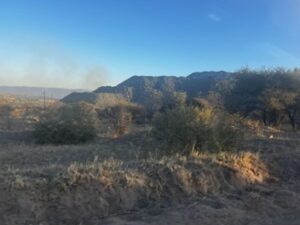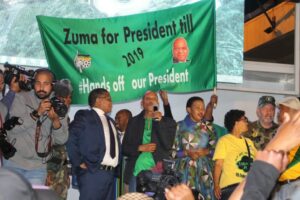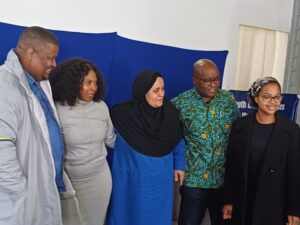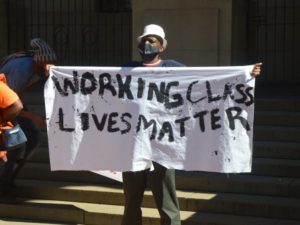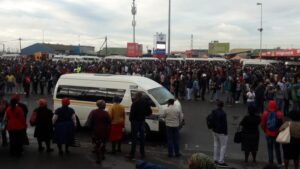Trade unionism and worker education, particularly in Africa, are rarely discussed through comparative lenses, and yet relatively highly industrialised countries in Africa have lessons for trade unions and workers the world over. The significant body of historical and contemporary literature on workers’ education in Nigeria and South Africa presents a valuable resource for comparative analysis. Nigeria became a British protectorate or client state protected by the British Empire in 1901. On the other hand, some parts of South Africa were first colonised by the Netherlands in 1652 and were taken over by the British Empire in 1806. Formal colonisation of Nigeria ended in 1960 while in South Africa, colonialism adopted the form of Apartheid, imposed by the powerful presence of settler colonialists, which formally ended in 1994.
To date, there has been a notable absence of such comparative studies. This opinion piece suggests that comparing workers’ education in both countries can provide new insights. Throughout history, workers’ education has been a point of contention among different political and ideological groups in Nigeria and South Africa. While workers often learn incidentally through daily interactions and struggles, such groups played a role in designing workers’ education. Structured workers’ education took the form of workshops, conferences, meetings, and media organised by political groups.
Workers’ education
In defining structured workers’ education from a South African perspective, there are three categories of workers’ education:
A radical approach, informed by various strands of socialist and left politics, aims to radically transform society for the benefit of workers in particular and the working class in general.
An instrumentalist approach focuses on providing worker leaders with skills and training to incrementally improve social and economic conditions and facilitate upward social mobility for workers.
The human capital perspective centres on training individual workers to enhance productivity and competitiveness, enabling them to access opportunities for upward social mobility in the workplace.
In Nigeria structured workers’ education is primarily based on what commentators refer to as ‘adult-liberal education’, which focuses on educating and training individuals to advance their career prospects in the workplace, similar to what can be described as the ‘human capital’ approach to workers’ education. Another strand of structured workers’ education was advanced by left-wing groups whose intentions were to overthrow colonialism and capitalism in Nigeria.
Workers’ education before independence in Nigeria
Before gaining independence, Nigerian employers organised workers’ education with the goal of establishing ‘sound industrial relations’. During the colonial era, the government financed workshops and established labour training institutes for workers and labour leaders. However, due to the Cold War, British imperialists were cautious about supporting radical workers’ education or any association with the Communist bloc. Instead, their main strategy was to create a non-radical and anti-Soviet industrial regime. Union leaders, colonial government labour officers, and multinational corporations operating in Nigeria facilitated workers’ education to prevent Nigerian workers from opposing colonialism in the workplace or society.
Workers from affiliates of the Nigeria Labour Congress at a May Day rally this year. Photo from NLC facebook page
The primary focus of the colonial regime in Nigeria was to establish anti-communist labour relations and pro-colonial workers’ education. This approach was intended to support the colonial system and the activities of multinational corporations in Nigeria. The colonial regime in Nigeria aimed to discourage unions aligned with the London-based International Confederation of Free Trade Unions (ICFTU) and the British Trade Union Congress (TUC) from joining the pro-Soviet World Federation of Trade Unions (WFTU).
In the 1940s and 1950s, influential Marxists such as Samuel Ikoku, Ayo Ogunseye, and Nuka Eze played a crucial role in providing radical workers’ education aimed at establishing a socialist or communist Nigeria. These dedicated activists established reading groups, conducted workshops, organised meetings, and engaged in various activities to promote their political perspectives, becoming influential figures in the anti-colonial struggle and the Nigerian labour movement.
Furthermore, strikes served as a powerful tool for promoting radical workers’ education in colonial Nigeria. In 1945, around 200,000 workers in Nigeria went on strike to support their demands for better wages, causing concern among imperialists, the colonial regime, and multinational companies operating in the colony. Workers’ education was used to moderate and influence trade unions and the workers themselves. In 1947, the British TUC collaborated with Nigeria’s labour department to organise workshops for trade union leaders in furtherance of this objective.
The media became an important tool used by the left-wing to educate workers. In April 1943, The Nigerian Worker was launched as a widely circulated newspaper linked to the first trade union centre, explicitly promoting a socialist perspective. It gained an impressive circulation of 10,000 in less than a year. However, in 1944, the colonial regime became concerned about the impact of workers’ education delivered through The Nigerian Worker to the extent that the newspaper was censored. The Labour Champion continued the workers’ education initiative when it was established in 1950. This took place during the brief existence of the Nigeria National Federation of Labour, which was founded in 1948. In the 1950s, young socialists organised educational workshops for tenants’ associations they formed in working-class residential areas in Nigeria.
Workers’ education before the end of formal Apartheid in South Africa
In 1919, the Industrial and Commercial Union (ICU) became a significant trade union dedicated to organising black workers across different sectors of the economy. The ICU’s organising and education programme focused on using meetings and its own media to educate black workers about their rights and interests. This approach led to rapid growth, challenging the relevance of the African National Congress (ANC), then in its infancy. At its peak between 1927 and 1928, the ICU had over 150,000 members.
However, internal disputes and a lack of strategic direction ultimately led to the demise of the ICU in the early 1930s. Starting in 1925, the Communist Party of South Africa, which later became the South African Communist Party, organised night schools in the slums of Johannesburg where workers had to rely on candlelight and had no access to desks or blackboards. Despite these challenges, they were taught to read and write, and engaged in discussions on intricate questions of political economy.
Founded in 1955, the South African Congress of Trade Unions (Sactu) considered itself a non-racial union aligned with the ANC. Sactu was a communist union that advocated a Marxist-Leninist version of Marxism. The union believed in a two-stage theory of revolution, which involved first achieving national liberation that would then transition to socialism, led by the working class. In 1956, the first national Sactu school was convened, providing a platform for young workers and organisers to learn from the experiences of veteran trade unionists such as Ray Alexander, John Nkadimeng and Eli Weinberg.
The 1960s marked a significant turning point in South African working class history in the sense that the manufacturing sector needed an urban-based working class with access to some very basic education and schooling. These factors contributed to the growth of urban dormitories or townships, the establishment of schools, and a notable increase in working class cultural activities. These developments paved the way for intensified working class resistance in 1973, 1976, and throughout the 1980s. Despite repression in the 1960s, workers continued to be involved in self-organised strikes, although the strikes were limited numerically. Non-governmental organisations, such as the Urban Training Project (UTP), educated workers about their rights, leading to the formation of nine industrial unions between 1972 and 1975. Between 1961 and 1971, the UTP educated about 51,000 workers and worker leaders.
In 1972, the South African Students’ Organisation (Saso) and the Black People’s Convention (BPC), both proponents of black consciousness politics akin to the black power movement of the United States of America (USA), jointly established the Black Workers Project (BWP). Inspired by the philosophy of Paulo Freire and the tenets of ‘liberation theology’, which emphasised that workers are a valuable source of knowledge and have the capacity to address their own challenges, the BWP and the broader black consciousness movement were also actively engaged in educating and mobilising black communities.
The momentum for these aforementioned initiatives received a significant boost from the strikes that unfolded in Durban. The historic Durban strike of 1973 began in January, and during the first quarter of the year, there were a total of 160 strikes involving 61,000 workers. These strikes played a pivotal role in fostering the growth of organisations dedicated to worker education and trade unions. In 1973, a group of predominantly middle class intellectuals and academics established the Institute of Industrial Education (IIE), followed by the founding of the South African Labour Bulletin in 1974. The IIE’s educational offerings included, among others, distance learning courses for workers. These courses featured handbooks that dealt with the economy, the law, the workplace, and worker organisation. The IIE’s educational methodology was rooted in the promotion of participatory democracy and the cultivation of a working class ethos that values democracy and accountability. All these principles found resonance in Paulo Freire’s Pedagogy of the Oppressed.
Saftu shopsteward council on May Day this year. Photo by Mzi Velapi
The aftermath of the Durban strikes led to the formation of industrial unions that still have a presence in post-apartheid South Africa. An example is the National Union of Metalworkers of South Africa (Numsa). Its largest component at the time, known as the Metal and Allied Workers Union (Mawu), was founded in 1974. These industrial unions coalesced to launch the Federation of South African Trade Unions (Fosatu) in 1979. Fosatu played a pivotal role in advancing structured workers’ education in the 1990s and early 1980s.
Academics and other intellectuals were instrumental in facilitating access to structured programmes for workers’ education. Additionally, in the 1980s, several labour support organisations were formed to conduct workers’ education activities across the country. In this regard, Eddie Webster wrote: “This involvement of academics in workers’ education was part of a broad flowering of labour support organisations, such as the Labour Research Services in Cape Town, and progressive research entities at universities, such as the Trade Union Research Project at the University of Natal and the History Workshop at the University of the Witwatersrand”.
The South African Committee for Higher Education Trust (Sached), founded in 1958, evolved to become the largest and arguably the most influential education NGO in South Africa by the 1980s. Sached demonstrated its adaptability by responding to the ongoing education crisis and the changing political landscape by constantly adjusting its curricula, making them relevant to current and local dynamics. One systematic response was the formation of its more radical wing, the Labour and Community Committee (Lacom), which undertook educational work with community organisations and trade unions. Lacom’s and Sached’s work continued with a radical working class orientation at Khanya College, which was established in 1986.
In conclusion, workers’ education in both countries was a contested terrain among various political currents. Workers’ education from the liberal perspective sought to call for cosmetic changes without radically transforming the political system in Nigeria before independence. In South Africa, by contrast, workers’ education before the end of formal Apartheid tended to be radical, despite being engineered by different political traditions of the liberation struggle. In both countries, various strands of socialists and communists – such as Stalinists, Trotskyists, workerists (in the case of South Africa) and social democrats – contributed to the development of structured workers’ education before the independence of Nigeria and before the end of formal Apartheid in South Africa.
